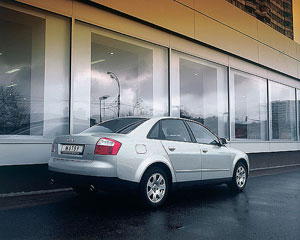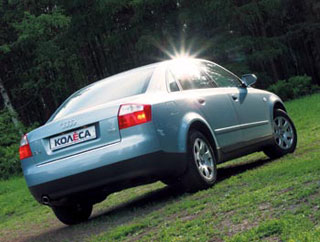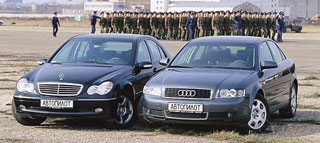Test drive Audi A4 B6 2001 - 2004 sedan
How many leaders do you need?
Four is better than two - is it so?Born for rally tracks, all -wheel drive cars soon reached civilian roads. Sports successes are one of the best consumer -demand catalysts. But, as usual, the more eloquent the arguments for, the more doubts. To put a pure experiment, there was not enough trifle - two identical cars with a different type of drive. Otherwise, after all, not concepts are compared, but real examples of their embodiment (see ZR, 1999, No. 5), which is not at all the same.
From heaven to earth
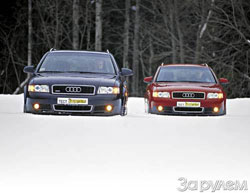 So, we have two almost identical cars. Audi A4 Avan with 1.8T engines and mechanical gearboxes. The whole difference in color, the small nameplate of Quattro on one of the cars and, of course, the drive of four wheels. On the Audi-Kvattro distribution of the torque between the front and rear axle, the worm differential of increased friction of torsen, which is not connected by electronic ties, traditionally heads. The principle of his work is already clear from the name - if, of course, to know that the torsen is not a Swedish surname, but the English abbreviation from Torque and Sensitive (literally sensitive to a torque). Thanks to him, the efforts of the motor do not disappear on the skid wheels, and at the same time it is flexible enough to redistribute the moment, tracking the change in the adhesion of the tires with the road. Interdaemoral differentials in the transmission of audi - free and additional contribution to controllability do not make.
So, we have two almost identical cars. Audi A4 Avan with 1.8T engines and mechanical gearboxes. The whole difference in color, the small nameplate of Quattro on one of the cars and, of course, the drive of four wheels. On the Audi-Kvattro distribution of the torque between the front and rear axle, the worm differential of increased friction of torsen, which is not connected by electronic ties, traditionally heads. The principle of his work is already clear from the name - if, of course, to know that the torsen is not a Swedish surname, but the English abbreviation from Torque and Sensitive (literally sensitive to a torque). Thanks to him, the efforts of the motor do not disappear on the skid wheels, and at the same time it is flexible enough to redistribute the moment, tracking the change in the adhesion of the tires with the road. Interdaemoral differentials in the transmission of audi - free and additional contribution to controllability do not make. 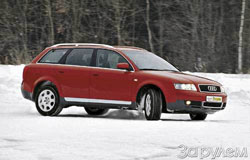 How much does 4x4 weighs - in the literal and figurative sense? According to our dimensions, Audi A4 Avan with QUATTRO Schildik is heavier than a front -wheel drive fellow 78 kg. According to the factory specification, the difference is 85 kg - we write it off to a different volume of the tank, the measurement error that managed to stick domestic dirt. Well, according to the official Audi dealers, the CVATRO version is harder for ... 3390 euros. The basic Avan 1.8t costs 30,650 euros, Kvattro - 34 040. The all -wheel drive kilogram is estimated at 43 euros - well, German mechanics have never been cheap.
How much does 4x4 weighs - in the literal and figurative sense? According to our dimensions, Audi A4 Avan with QUATTRO Schildik is heavier than a front -wheel drive fellow 78 kg. According to the factory specification, the difference is 85 kg - we write it off to a different volume of the tank, the measurement error that managed to stick domestic dirt. Well, according to the official Audi dealers, the CVATRO version is harder for ... 3390 euros. The basic Avan 1.8t costs 30,650 euros, Kvattro - 34 040. The all -wheel drive kilogram is estimated at 43 euros - well, German mechanics have never been cheap. What, in fact, are the advantages of all -wheel drive? The most important - the torque of the engine is distributed to all wheels, so that the entire mass of the machine is involved in creating a traction force. In other words, the coupling weight of an all -wheel drive car is equal to its weight, and not half or even 60%. Naturally, on slippery roads, this gives considerable benefits. Let's try to evaluate them.
Only mountains can be better than mountains
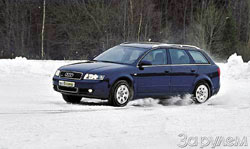 The steep rises on the roads of the Dmitrovsky auto policy are littered with fresh snow in half a meter depth, but 12 and 16% are quite accessible to us. Rolled wet snow at a temperature of about 0C instantly turns under the wheels into smooth ice. Even thoroughbred winter tires, such a coating is not on the teeth - inadvertently added gas, and the front -wheel drive Audi is not able to move on the smaller of the ascent. However, with accurately working with a clutch and gas, this exercise is quite capable of a medium qualification driver. But the rise of 16% sets completely different grades - if the audi with the QUATTRO nameplate confidently moves and accelerates up, then it remains to be helplessly rotating with wheels - such lifts are subject to it only from overclocking.
The steep rises on the roads of the Dmitrovsky auto policy are littered with fresh snow in half a meter depth, but 12 and 16% are quite accessible to us. Rolled wet snow at a temperature of about 0C instantly turns under the wheels into smooth ice. Even thoroughbred winter tires, such a coating is not on the teeth - inadvertently added gas, and the front -wheel drive Audi is not able to move on the smaller of the ascent. However, with accurately working with a clutch and gas, this exercise is quite capable of a medium qualification driver. But the rise of 16% sets completely different grades - if the audi with the QUATTRO nameplate confidently moves and accelerates up, then it remains to be helplessly rotating with wheels - such lifts are subject to it only from overclocking. Acceleration, more acceleration
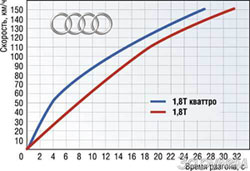 How much more effective is the all -wheel drive car accelerate along a slippery road? On the rolled snow (see table and graph) up to 40 km/h Audi A4 Avan Croatro is approximately twice as much as the front -wheel drive, and it increases the advantage to about 80 km/h. Above, the dynamics is limited to the engine power, and not with the adhesion parameters, so after 100 km/h the advantage of a full -wheel drive for a machine with a specific power of about 100 liters. S./T is lost. However, this is true only for rolled snow with a clutch coefficient of 0.3-0.4. The more slippery the coating will be, the higher this threshold.
How much more effective is the all -wheel drive car accelerate along a slippery road? On the rolled snow (see table and graph) up to 40 km/h Audi A4 Avan Croatro is approximately twice as much as the front -wheel drive, and it increases the advantage to about 80 km/h. Above, the dynamics is limited to the engine power, and not with the adhesion parameters, so after 100 km/h the advantage of a full -wheel drive for a machine with a specific power of about 100 liters. S./T is lost. However, this is true only for rolled snow with a clutch coefficient of 0.3-0.4. The more slippery the coating will be, the higher this threshold. 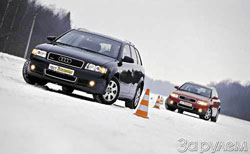 And yet the answer was by no means simple. It's all about the ESP stabilization system. The audi provides only two modes of its work - either the full control of the car, including traction on the wheels, or its complete absence. Can an experienced driver outplay automation during acceleration? Our answer is affirmative. Moreover, by car with one pair of leading, its advantage is very weighty - more than three seconds in acceleration to 100 km/h. The all -wheel drive scatters much more frozen, but here a person retains a leading position. Although not so convincing: 0.5-0.6 C to 100 km/h.
And yet the answer was by no means simple. It's all about the ESP stabilization system. The audi provides only two modes of its work - either the full control of the car, including traction on the wheels, or its complete absence. Can an experienced driver outplay automation during acceleration? Our answer is affirmative. Moreover, by car with one pair of leading, its advantage is very weighty - more than three seconds in acceleration to 100 km/h. The all -wheel drive scatters much more frozen, but here a person retains a leading position. Although not so convincing: 0.5-0.6 C to 100 km/h. However, in the failure of the electronics, not only those who compiled the ESP program, but also the characteristic of the boost engine 1.8t are guilty. If the ESP intervention strangles the engine below 1,500 rpm, then it will take time to come to the operating mode, when the turbocharger will revive it. Without a doubt, with an atmospheric engine, ESP loss would not be so noticeable.
The worst results in acceleration were obtained precisely when the driver helped the system, taking the gas pedal with an increase in slipping. The conclusion is unequivocal - it is necessary to trust electronics, even if the usual reflexes and driver’s experience dictate the opposite.
Together or instead?
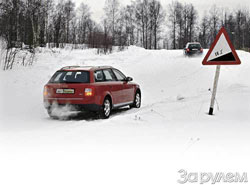 Why did we pay so much attention to acceleration? Yes, because it is he who determines the advantage of an all -wheel drive car on a winding highway. The speed of movement in the arc is limited by the tire grip coefficient - even faster, and the car will not hold on the trajectory, whether it has four or two leading wheels. Yes, of course, a car with one leading axis should be more sensitive to changing the thrust on wheels or driving. In fact, Audi A4 Avan Croatro, unambiguously more stable in a straight line, turned out to be more nervous in a limiting bend, sharply throwing the feed for gas discharge. However, the one who expects such a reaction will not surprise. Moreover, the absence of the rear axle is easily converted into gliding with all four wheels, allowing ...
Why did we pay so much attention to acceleration? Yes, because it is he who determines the advantage of an all -wheel drive car on a winding highway. The speed of movement in the arc is limited by the tire grip coefficient - even faster, and the car will not hold on the trajectory, whether it has four or two leading wheels. Yes, of course, a car with one leading axis should be more sensitive to changing the thrust on wheels or driving. In fact, Audi A4 Avan Croatro, unambiguously more stable in a straight line, turned out to be more nervous in a limiting bend, sharply throwing the feed for gas discharge. However, the one who expects such a reaction will not surprise. Moreover, the absence of the rear axle is easily converted into gliding with all four wheels, allowing ... 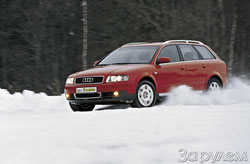 That's right, to begin to accelerate long before leaving the turn, thereby winning a fraction of a second. And on a winding ring track, they developed about 4 seconds of advantages over the front -wheel drive car. This is the expert - the driver who has only basic skills in managing the all -wheel drive machine, the winnings are twice more modest. And the ordinary driver remains at all (in the best scenario) in his own. At the wheel of a front -wheel drive audi on a winding slippery highway, the driver is more tense, more often adjusts the trajectory and makes movements with a steering wheel with greater amplitude. Control of all -wheel drive, at first glance, requires less effort. However, with an error in choosing a trajectory, a quick correction of the steering wheel with significant corners of rotation will be needed. We have already noted this feature of Audi Avvan Avan Kvattro (ZR, 2003, No. 1).
That's right, to begin to accelerate long before leaving the turn, thereby winning a fraction of a second. And on a winding ring track, they developed about 4 seconds of advantages over the front -wheel drive car. This is the expert - the driver who has only basic skills in managing the all -wheel drive machine, the winnings are twice more modest. And the ordinary driver remains at all (in the best scenario) in his own. At the wheel of a front -wheel drive audi on a winding slippery highway, the driver is more tense, more often adjusts the trajectory and makes movements with a steering wheel with greater amplitude. Control of all -wheel drive, at first glance, requires less effort. However, with an error in choosing a trajectory, a quick correction of the steering wheel with significant corners of rotation will be needed. We have already noted this feature of Audi Avvan Avan Kvattro (ZR, 2003, No. 1). The stabilization system will level the results of drivers of different qualifications. Recall that the current ESP on both versions of Audi is not able to adequately perceive the sliding with all four - it seeks to force the car to move in the direction set by the front axle, and for the sake of this removes the excess, in its opinion, thrust. By the way, according to our observations, the ESP intervention on the all -wheel drive audi is much less noticeable. The reason is obvious - the four leading wheels skid much less often than two, and therefore ESP does not besiege the engine once again.
There is an opinion
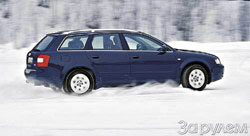 They interpret about the insidious morals of all -wheel drive cars. Say, until a certain point, everything is fine, and then ... Most likely, distrust arose due to typical errors: the entrance to the turn at high speed, too much angle of rotation of the steering wheel, skidding and loss of control over the car ... Yes, stability to A direct deceiving - even in our experiment, an ordinary driver, crossing the all -wheel drive audi, began to drive into the turn faster, and it was not ready for the car reaction to this ... ESP arrived just in time - however, it was for such situations that it was conceived.
They interpret about the insidious morals of all -wheel drive cars. Say, until a certain point, everything is fine, and then ... Most likely, distrust arose due to typical errors: the entrance to the turn at high speed, too much angle of rotation of the steering wheel, skidding and loss of control over the car ... Yes, stability to A direct deceiving - even in our experiment, an ordinary driver, crossing the all -wheel drive audi, began to drive into the turn faster, and it was not ready for the car reaction to this ... ESP arrived just in time - however, it was for such situations that it was conceived. Another judgment was confirmed unanimously: an all -wheel drive car is subjectively heavier on the go. However, not only subjectively: for the period of the test, the front -wheel drive car ran about 10% less in the same conditions in the same conditions.
SNOW IS FALLING...
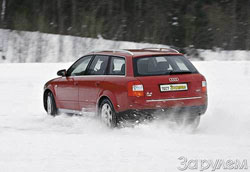 No matter how the manufacturers say that they create all -wheel drive cars not at all for the sake of increasing patency, it is still striving to check. We could not resist and, since, the site at the end of the dynamometric road was covered with an even layer of snow about 20 cm thick. Even the Audi A4 overcame it with great difficulty - which is not surprising with a road lumen of 130 mm. His front -wheel drive fellow was able to enter the snow target only with a small acceleration and advanced at half the distance. However, periodically handing back and ramming the rut, both were able to move forward tolerably. So without an appropriate road clearance, there is no need to talk about all -terrain qualities.
No matter how the manufacturers say that they create all -wheel drive cars not at all for the sake of increasing patency, it is still striving to check. We could not resist and, since, the site at the end of the dynamometric road was covered with an even layer of snow about 20 cm thick. Even the Audi A4 overcame it with great difficulty - which is not surprising with a road lumen of 130 mm. His front -wheel drive fellow was able to enter the snow target only with a small acceleration and advanced at half the distance. However, periodically handing back and ramming the rut, both were able to move forward tolerably. So without an appropriate road clearance, there is no need to talk about all -terrain qualities. And yet: for or against?
Do not wait for a definite answer. Firstly, the benefits of all-wheel drive are directly proportional to the specific power. In other words, on a 70 -horsepower low -profication, he hardly shows himself from the best side (a rare exception is the assault on icy rises). Secondly, modern ESP systems are not yet able to use the advantages of all-wheel drive. Thirdly, only a prepared driver can implement many of the possibilities of such a car.
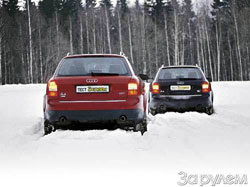 And as a result? If the car is only a means for delivery from point A to point B, and the driver’s experience and experience are small, then, probably, you should not pay attention to all -wheel drive modification. This is still not an all -terrain vehicle, but the money saved will be enough for at least a chic vacation for the whole family ...
And as a result? If the car is only a means for delivery from point A to point B, and the driver’s experience and experience are small, then, probably, you should not pay attention to all -wheel drive modification. This is still not an all -terrain vehicle, but the money saved will be enough for at least a chic vacation for the whole family ... It is another matter when the car is not only transport, but also hobby and hobbies. If you do not spare funds for your improvement as a driver and want to enjoy new opportunities. In this case, there is no alternative to a complete drive.
Front -wheel drive - it is necessary to correct the trajectory with the steering wheel.
Full -wheel drive is a turn with gliding with all four wheels.
In deep snow, the advantage of an all -wheel drive car is very noticeable.
The fracture site indicates the cessation of wheel slipping. Data on the best attempts to accelerate without ESP.
Text / Anatoly Fomin
Photo / George Sadkov
A source: The magazine "Driving"
Video test drives Audi A4 B6 2001 - 2004
Video crash tests Audi A4 B6 2001 - 2004
Test drives Audi A4 B6 2001 - 2004
Crash Test Audi A4 B6 2001 - 2004
Krassh Test: Detailed Information30%
Driver and passengers
7%
Pedestrians
Malfunctions Audi A4 B6 2001 - 2004
Audi A4 malfunctions: Detailed information| A4 B6 2001 - 2004 | |
|---|---|
| Engine |  |
| Transmission |  |
| Control system and suspension |  |
| Brake system |  |
| Air heating and air conditioning |  |
| Launch and charging system |  |
| Electric components and so on |  |
| Corrosion body stability |









